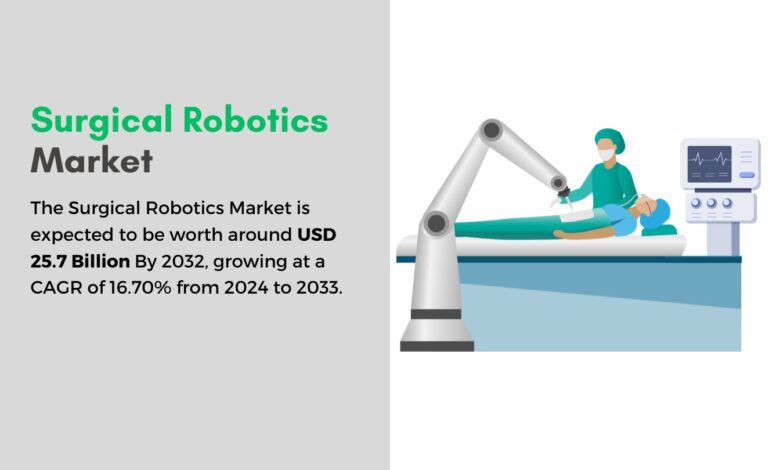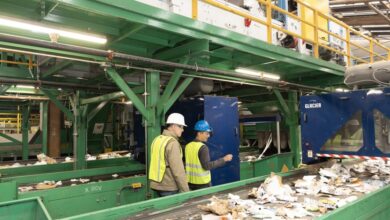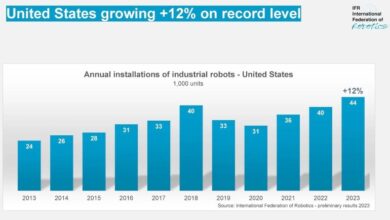Surgical Robotics Market To Hit USD ~25 Bn by 2032

Introduction
The global surgical robotics market has experienced significant growth, primarily driven by technological advancements and the growing demand for minimally invasive surgeries. In 2022, the market was valued at USD 6.2 billion and is expected to reach around USD 25.7 billion by 2032, with an annual growth rate of 15.70% from 2023 to 2032.
This growth is attributed to several factors including the increase in the elderly population, the rising prevalence of chronic diseases like cancer and cardiovascular conditions, and continuous technological innovations in robotic systems, which contribute to the rise in demand for surgical robots. Furthermore, the high precision and reduced recovery times associated with robotic surgeries make them attractive to both healthcare providers and patients.
However, the market faces challenges such as the high cost of robotic surgical systems and the need for specialized training for surgeons, which may limit adoption, particularly in lower-income regions. Additionally, potential technical failures and the high cost of maintenance present risks.
The recent developments in the surgical robotics market have been marked by significant mergers, acquisitions, and funding activities. For example, in April 2024, Asensus Surgical proposed a full acquisition by Karl Storz SE & Co. KG at $0.35 per share, representing a 66.7% premium on its stock price. This also includes a bridge loan of up to $20 million to support Asensus during negotiations.
Another significant event is CMR Surgical’s Series D financing round, raising $600 million led by SoftBank Vision Fund 2 and Ally Bridge Group to accelerate the global commercialization of the Versius robotic system and enhance its digital ecosystem. Additionally, Johnson & Johnson is considering a multibillion-dollar acquisition of Auris Health, aiming to enhance its portfolio with advanced robotic systems for lung cancer diagnosis and treatment.
These strategic moves highlight the dynamic growth and investment in the surgical robotics sector, fostering advancements in technology and global market expansion.
Key Takeaways
- The global surgical robotics market is anticipated to reach a valuation of approximately USD 25.7 billion by 2032, witnessing a robust CAGR of 15.7% from 2022’s USD 6.2 billion.
- Robotic surgeries are gaining prominence due to technological advancements, such as 3D HD imaging sensors, cameras, robotics calculations, and remote navigation systems.
- The accessory segment, encompassing robot components, is poised to dominate the market, holding an estimated 49% share.
- In 2022, neurosurgery emerged as a lucrative segment and is anticipated to maintain its dominance.
- Hospitals are the primary users of surgical robotics, accounting for a significant 73% market share in 2022, expected to persist in the foreseeable future.
- North America leads the market, capturing 51% of revenue in 2022.
- Emerging key players are adopting diverse strategic policies to enhance their presence in foreign markets, focusing on new-generation robotic equipment and technology advancements.
Surgical Robotics Statistics
- Approximately 10% of all general surgeries in Europe are conducted using robotic systems, indicating a notable adoption rate in the region.
- Globally, over 1 million robotic surgeries are performed each year, demonstrating the widespread utilization of this technology across various medical procedures.
- In the United States, robotic-assisted surgeries contribute to about 15% of all surgical interventions, showcasing a significant presence in the healthcare landscape.
- More than 30 types of surgeries can be conducted with robotic assistance, showcasing the versatility and applicability of this technology across diverse medical fields.
- Robotic surgery platforms typically entail costs ranging between $1 million and $2.5 million each, representing a considerable investment for healthcare institutions.
- The da Vinci Surgical System stands out as the most prevalent robotic surgery platform, facilitating over 90% of all robotic procedures worldwide.
- Surgeons utilizing robotic systems report a significant reduction of approximately 60% in physical strain during surgical procedures, highlighting the ergonomic advantages of this technology.
- Patient satisfaction with robotic surgery surpasses traditional methods, with around 70% of patients expressing higher levels of contentment with their surgical experience.
- Robotic surgeries boast an impressive success rate of approximately 98%, underscoring the efficacy and reliability of this approach.
- Among the most common robotic surgeries are prostatectomy, hysterectomy, and colorectal surgery, indicating prevalent applications across various medical specialties.
- Robotic surgery platforms are operational in over 4,000 hospitals globally, showcasing widespread integration into healthcare infrastructure.
- The complication rate associated with robotic surgeries is notably lower, standing at about 1.5% compared to 2.8% for traditional surgical procedures.
- Robotic surgery for knee replacement can reduce post-operative pain by 30%, offering enhanced patient comfort and recovery outcomes.
- Heart valve repairs assisted by robotic surgery reduce average surgical time by 25%, streamlining procedural efficiency.
- Robotic surgery significantly reduces the risk of infection by approximately 50% compared to open surgery, enhancing patient safety outcomes.
- Patients undergoing robotic surgery typically experience a 25% faster recovery time compared to traditional surgical methods, facilitating quicker post-operative recuperation.
- Robotic surgery can reduce hospital stays by an average of 20%, contributing to more efficient resource utilization.
- The average training time required for surgeons to achieve proficiency in robotic surgery is approximately 80 hours, highlighting the importance of specialized training programs in ensuring optimal surgical outcomes.
Recent Developments
Acquisitions and Mergers
- Asensus Surgical and Karl Storz: Asensus Surgical entered into a non-binding letter of intent with Karl Storz SE & Co. KG for a full acquisition. The proposed acquisition price is $0.35 per share, a 66.7% premium on Asensus’s stock price, and includes a $20 million bridge loan to support operations during the exclusivity period.
- Johnson & Johnson and Auris Health: Johnson & Johnson is considering a multibillion-dollar acquisition of Auris Health. This move aims to integrate Auris’s advanced robotic systems for lung cancer diagnosis and treatment into J&J’s existing portfolio.
- Stryker and Artelon: Stryker announced a definitive agreement to acquire Artelon, a company specializing in soft tissue fixation, to enhance its surgical robotics capabilities.
Funding
- CMR Surgical: CMR Surgical raised $600 million in a Series D financing round led by SoftBank Vision Fund 2 and Ally Bridge Group. The funds will be used to expand the global commercialization of the Versius robotic system and develop its digital ecosystem.
- Restor3D: Restor3D secured $70 million in a recent financing round to enhance its surgical robotics technology.
New Product Launches
- Smith+Nephew: In November 2022, Smith+Nephew launched the JOURNEY II ROX Total Knee Solution, a new product aimed at improving knee arthroplasty procedures with advanced materials and anatomic design.
- Medtronic: In October 2021, Medtronic received CE Mark approval for its Hugo robotic-assisted surgery system, allowing its sale in Europe for urologic and gynecologic procedures.
- CMR Surgical: CMR Surgical launched the Versius Surgical Robotic System in various regions including Europe, Australia, and the Middle East as part of its international expansion efforts.
Collaborations
- CMR Surgical and Ethicon: In November 2022, CMR Surgical announced a collaboration with Ethicon, a Johnson & Johnson MedTech company, to expand the use of surgical robotics and advanced laparoscopic instruments.
- Auris Health and NeuWave Medical: Auris Health partnered with NeuWave Medical to add microwave ablation capabilities to its Monarch robotic bronchoscope, enhancing its ability to detect and treat lung tumors.
Use Cases
- General Surgery: Surgical robots like the Da Vinci Surgical System are extensively used for procedures such as hysterectomies, prostatectomies, and heart valve repairs. These systems enhance precision, reduce recovery times, and minimize surgical risks.
- Orthopedic Surgery: Robotics in orthopedic surgery, such as knee and hip replacements, has been revolutionized by systems like Mako by Stryker. These robots improve the accuracy of bone cuts and implant placements, leading to better patient outcomes and faster recovery.
- Neurosurgery: Advanced robotic systems are used in neurosurgery for tasks like brain tumor removal and spinal surgery. Systems like Paradigm by Proprio Vision offer real-time 3D visualization and enhanced precision, which are crucial for these delicate procedures.
- Urological Surgery: Robotic systems are commonly used in urological procedures, including prostatectomies and kidney surgeries. These robots allow for minimally invasive surgeries, which result in less pain and quicker recovery times for patients.
- Gynecological Surgery: In gynecology, robots assist with procedures such as hysterectomies and myomectomies. The precision and control offered by surgical robots reduce complications and improve surgical outcomes.
- Cardiothoracic Surgery: Surgical robots are used for heart and lung surgeries, enabling minimally invasive approaches that reduce the risk of infection and shorten hospital stays. The improved precision also contributes to better patient outcomes.
- Spinal Surgery: Robotics in spinal surgery helps in the accurate placement of screws and other hardware, reducing the risk of complications. These systems are particularly beneficial for complex spinal reconstructions.
- Pediatric Surgery: Robotic systems are increasingly being used in pediatric surgeries to perform delicate procedures with high precision, minimizing the impact on small and sensitive bodies.
- Emergency and Trauma Surgery: Robotic-assisted surgeries in emergency settings allow for quick, precise interventions, which are critical in trauma cases. These robots help stabilize patients with less invasive procedures, reducing recovery times.
- Oncological Surgery: In cancer treatment, robotic systems are used to remove tumors with minimal damage to surrounding tissues. This is particularly important in surgeries for prostate, lung, and colorectal cancers.
Conclusion
In conclusion, the global surgical robotics market is set to expand significantly over the next decade, supported by technological advancements and a growing preference for minimally invasive surgeries. While challenges remain, the continued innovation and strategic collaborations in the industry are likely to drive sustained growth and broader adoption of surgical robotics worldwide.



